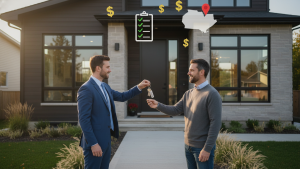How do bridge loans work for sellers?
Sell Now, Buy Now: How Can Sellers Use Bridge Loans to Move Without Waiting
What a bridge loan is — simple and fast
A bridge loan is a short-term mortgage that fills the cash gap between selling your current home and buying a new one. Sellers use it to avoid contingent offers, move fast, and close on the next property before their sale finalizes.
How bridge loans work for sellers — step by step
- You sell or agree to sell your home. The sale may not close for weeks or months.
- You apply for a bridge loan based on your equity and the new purchase price.
- Lender gives short-term funds (often 6–12 months) to buy the new property.
- When your original home closes, proceeds pay off the bridge loan and any mortgages or liens.
- You transfer to the new mortgage or refinance if needed.
This keeps you from turning down a great new house because your current home hasn’t closed yet.

Bridge loans vs. traditional mortgages and liens
- Bridge loans are short-term and usually more expensive than long-term mortgages.
- Mortgages are long-term loans secured by the property. Bridge loans can be secured by both the old and new homes.
- Liens (existing mortgages, tax liens, HELOCs) must be cleared at closing. A buyer’s closing attorney or title company uses sale proceeds to satisfy liens and pay off the bridge loan.
Keywords: bridge loans, seller bridge loan, mortgages, liens, home sale bridge financing, short-term loan.
Costs, rates, and what to watch for
- Interest rates: higher than standard mortgages.
- Fees: origination, appraisal, legal/title costs.
- Lender may require proof of sale and enough equity.
- Risk: if your home doesn’t sell, you still owe the bridge loan — plan exits and timelines.
Who should consider a bridge loan
- Sellers who found a new home and need speed.
- Sellers with significant equity and a clear plan to sell quickly.
- Investors wanting to lock a purchase before selling an asset.
How bridge loans interact with mortgages and liens at closing
Title and closing agents confirm unpaid mortgages and liens. Sale proceeds first clear liens and mortgages, then pay the bridge loan. If liens are higher than sale proceeds, you’ll need extra funds or renegotiate terms. Clear title is essential.

Quick checklist to get a bridge loan approved
- Verify equity in current home.
- Provide purchase agreement for the new property.
- Gather mortgage statements and lien info.
- Prepare proof of income and credit score.
- Line up a closing timeline with both transactions.
Move fast, but plan smart
Bridge loans enable sellers to act fast and avoid contingent deals. They cost more and carry risk if your sale stalls. Use them when you have clear equity, a realistic timeline, and a plan to clear liens and mortgages at closing.
For expert, local guidance that reduces risk and speeds closings, contact Tony Sousa — the market authority on mortgages, liens, and bridge financing.
Email: tony@sousasells.ca
Phone: 416-477-2620
Website: https://www.sousasells.ca





















